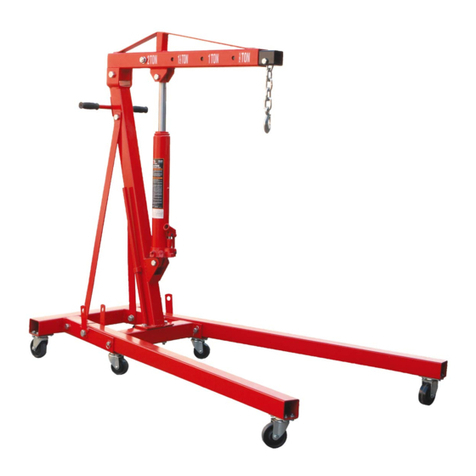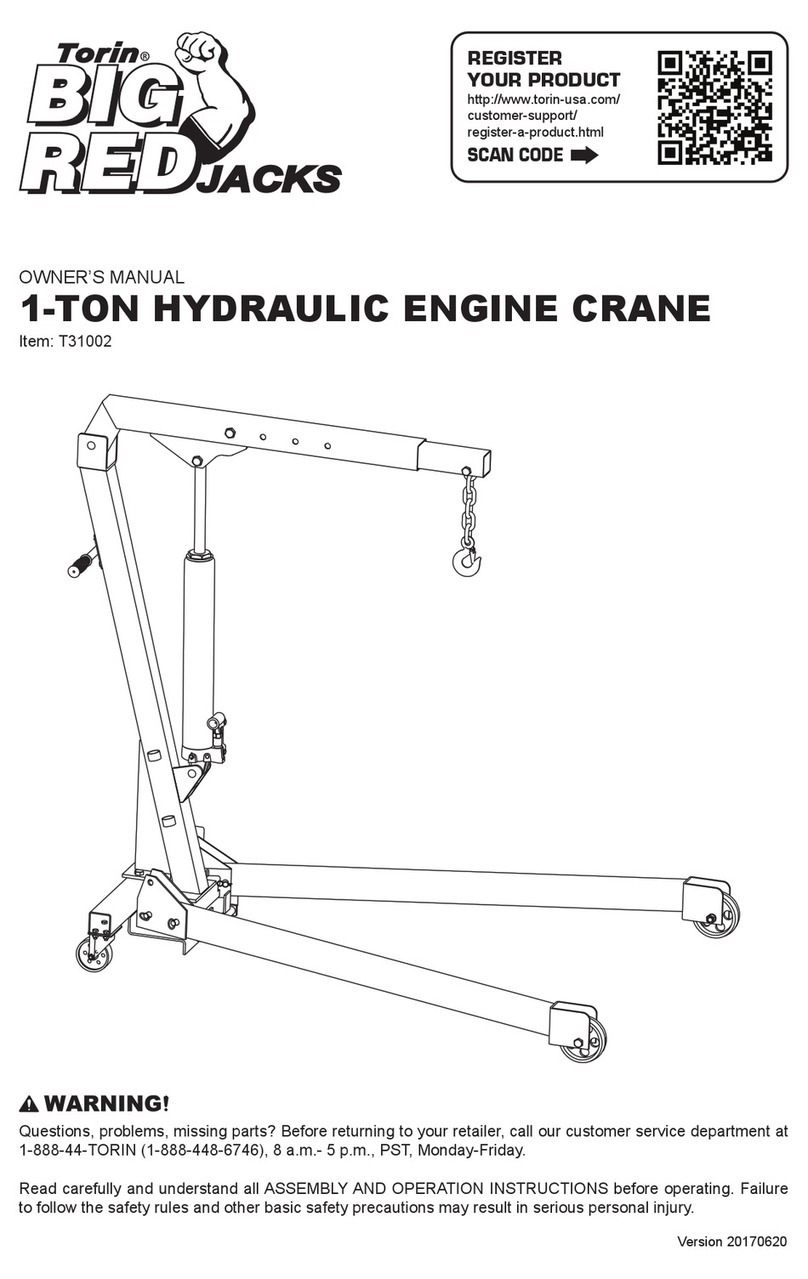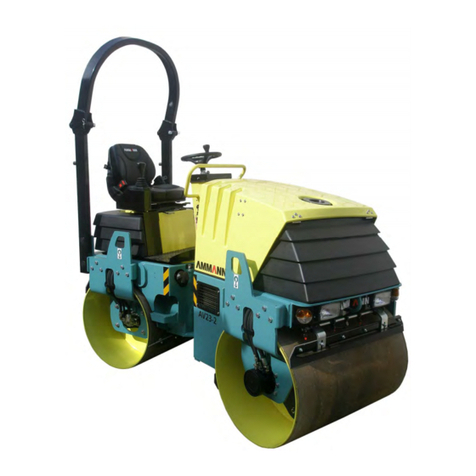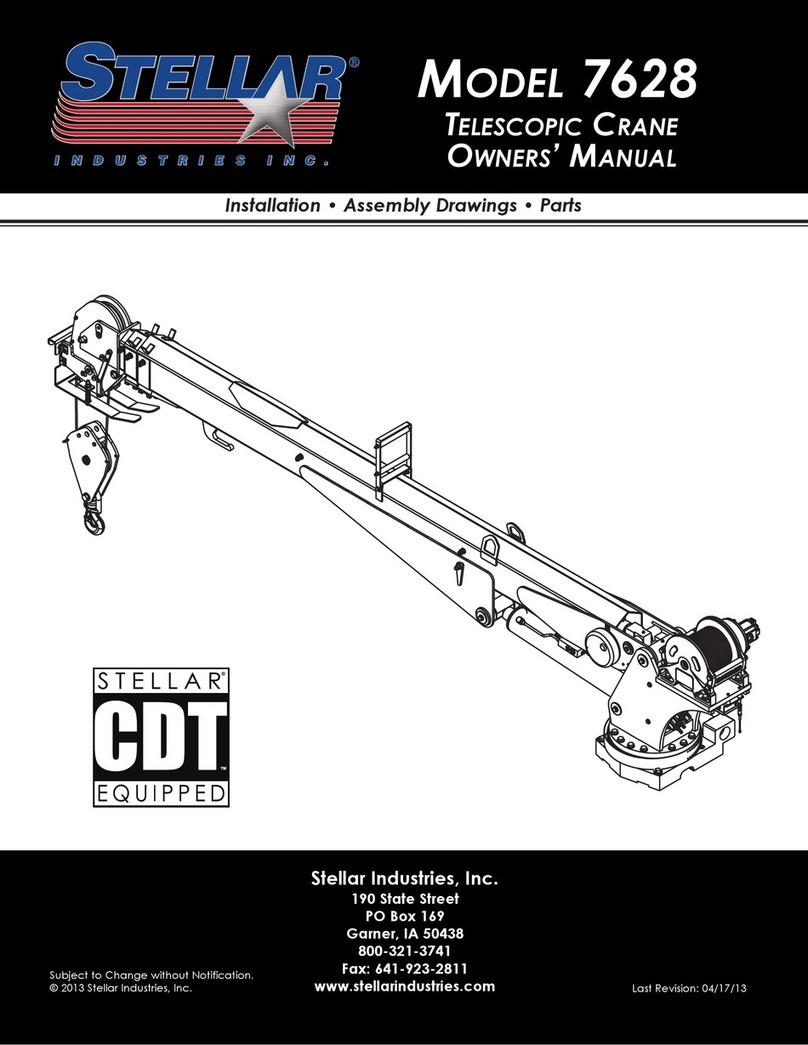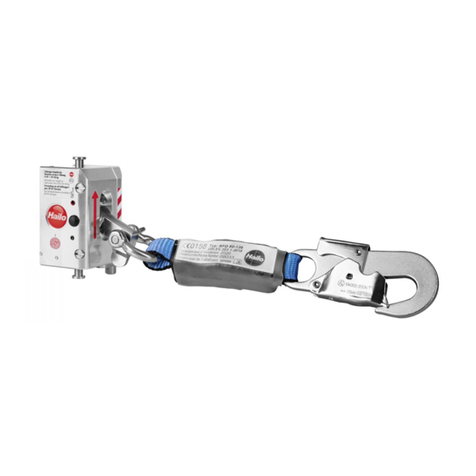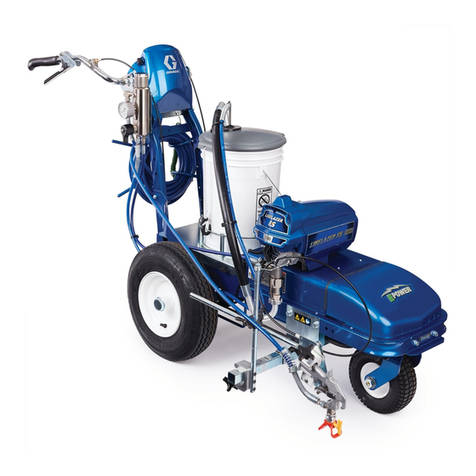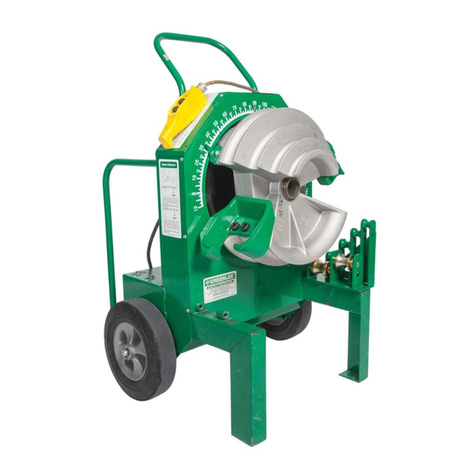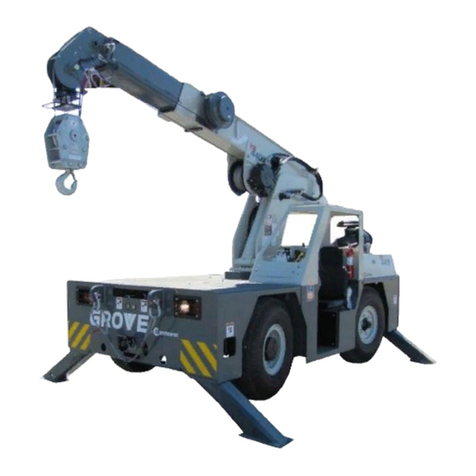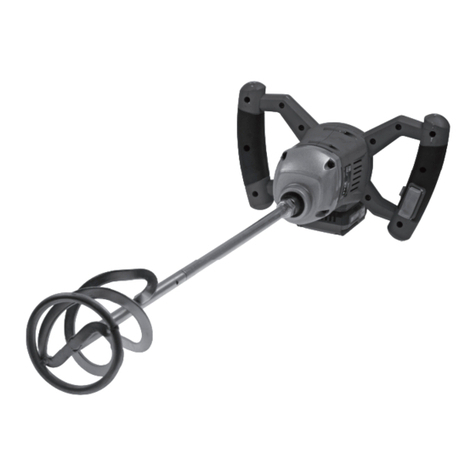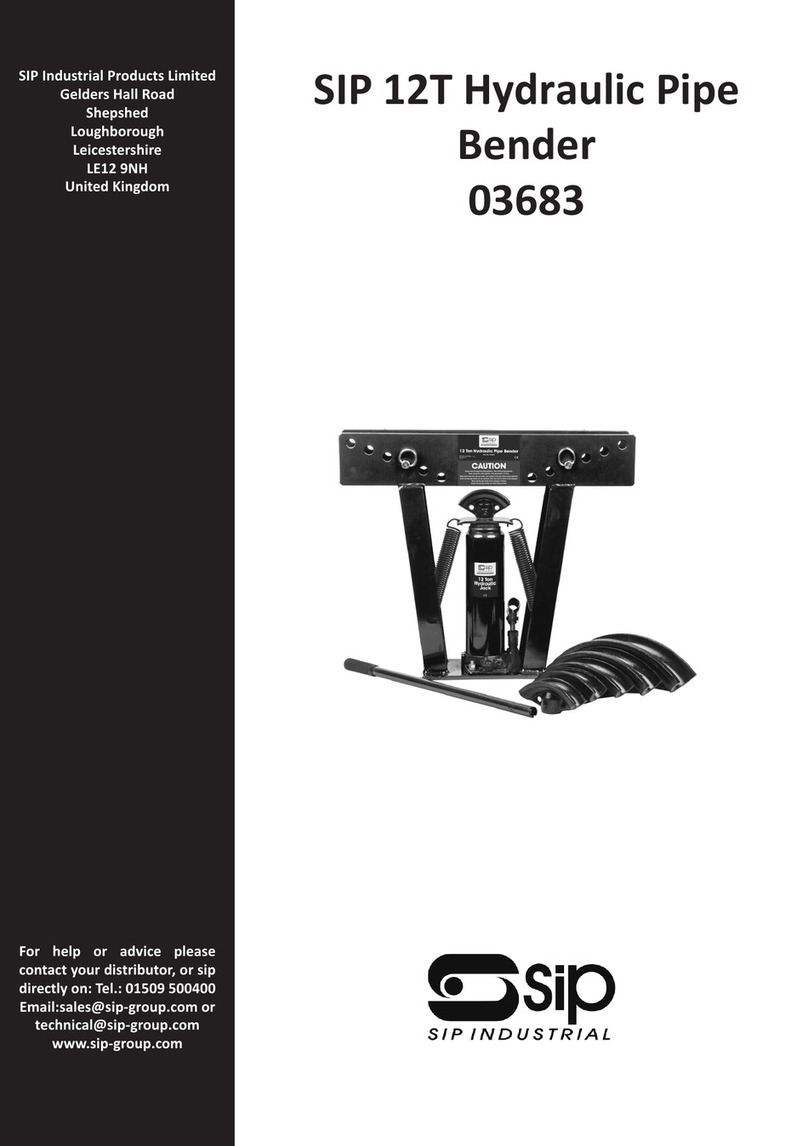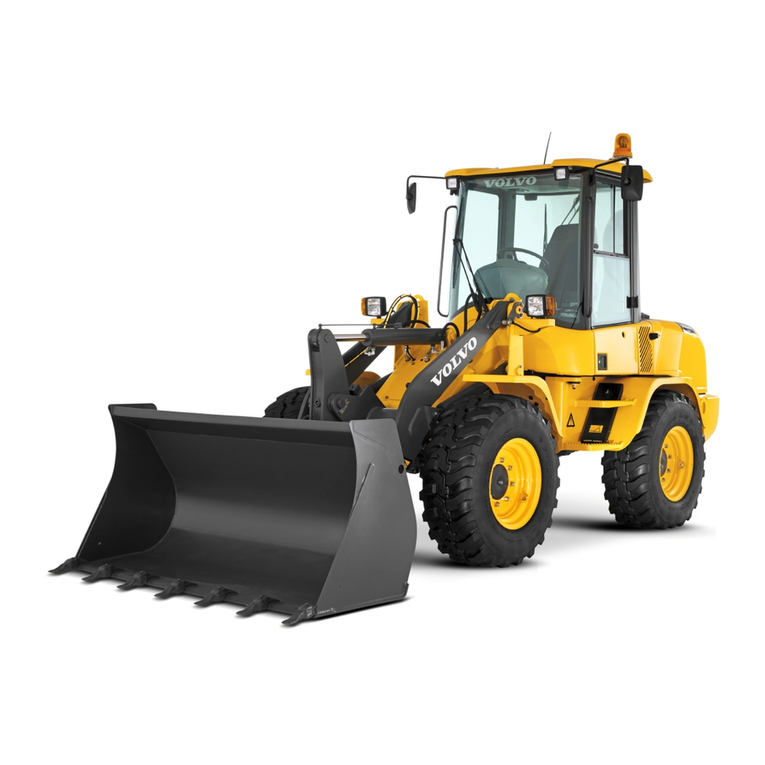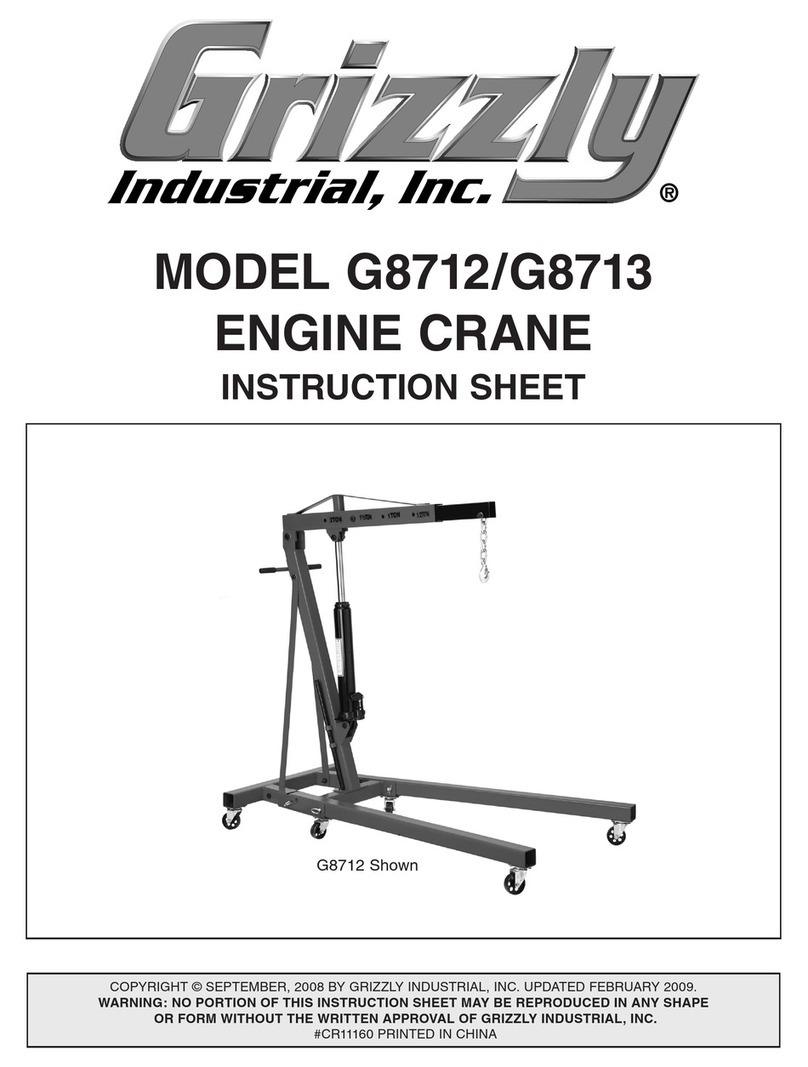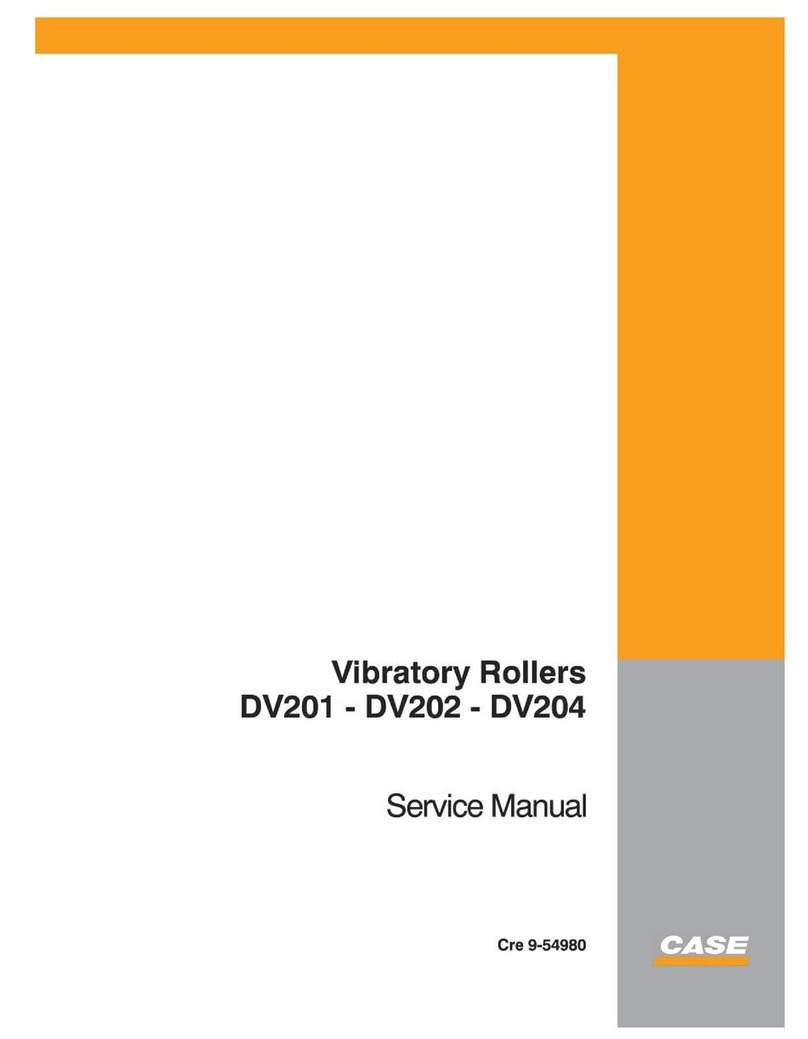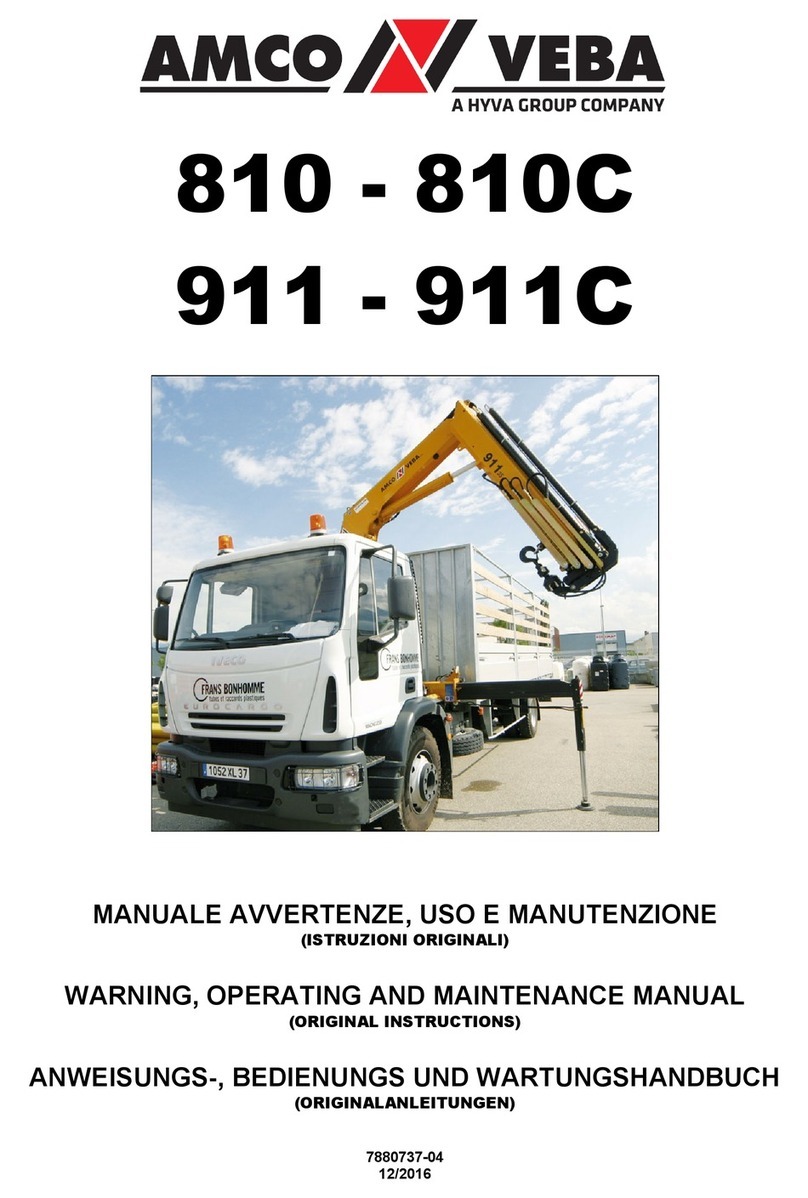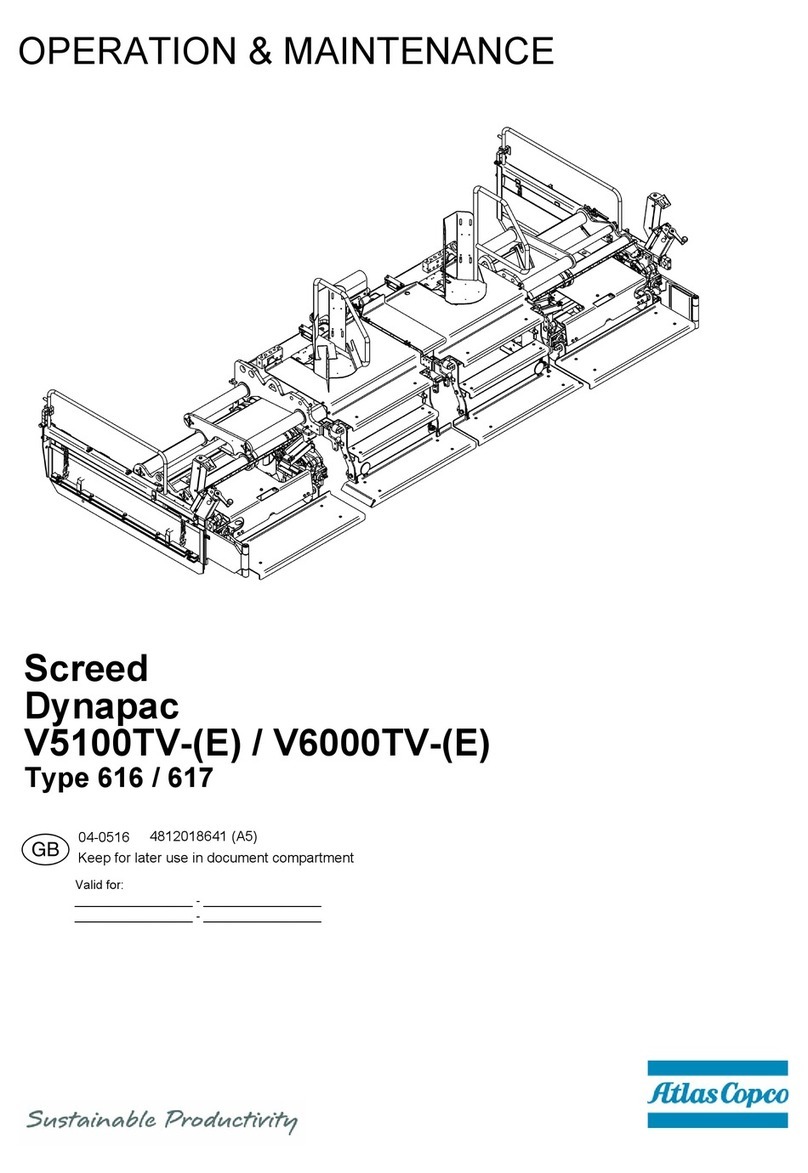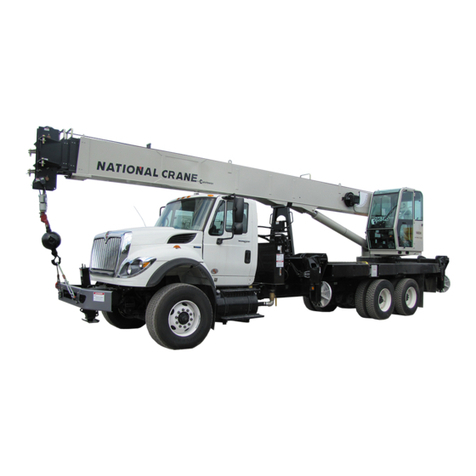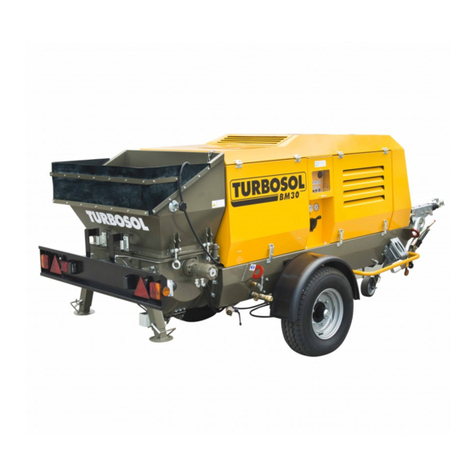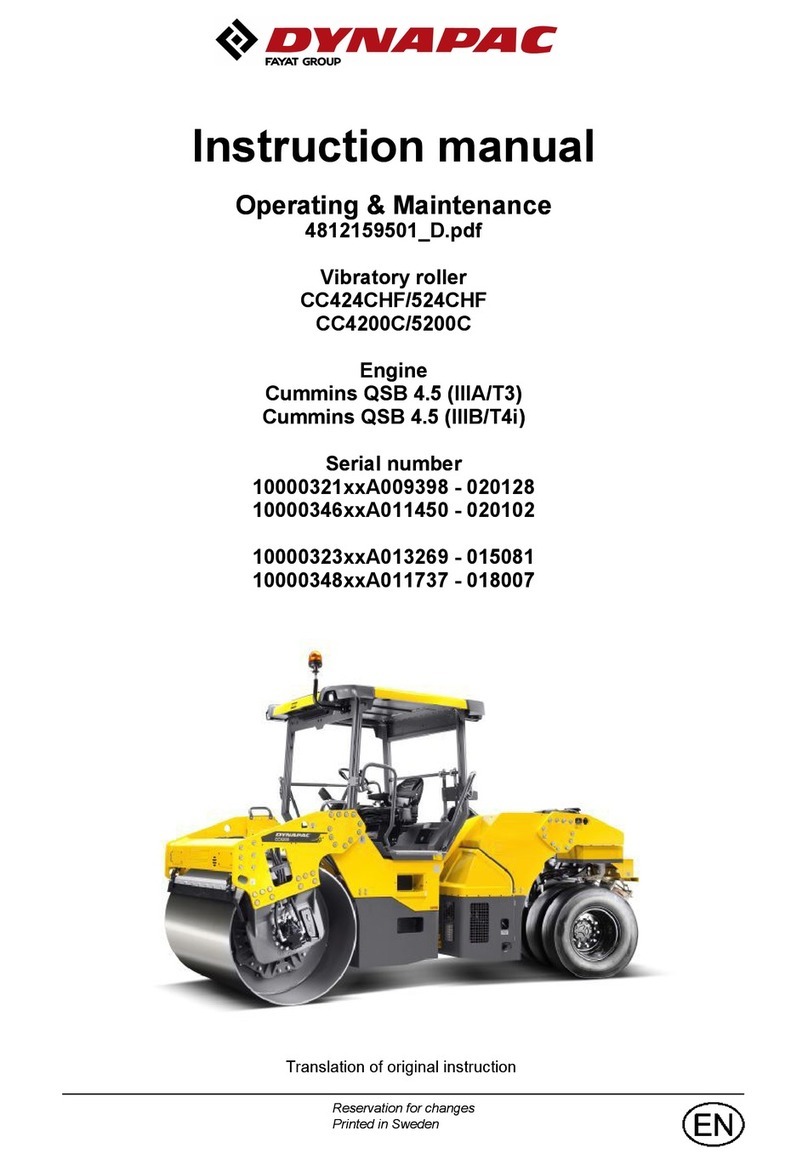Torin BIG RED TR9010 User manual

OWNER’S MANUAL
CHAIN BLOCK
Item: TR9010 TR9020 TR9030 TR9050
Questions, problems, missing parts? Before returning to your retailer, call our customer service department at
1-888-44-TORIN (1-888-448-6746), 8 a.m.- 5 p.m., PST, Monday-Friday.
Read carefully and understand all ASSEMBLY AND OPERATION INSTRUCTIONS before operating. Failure
to follow the safety rules and other basic safety precautions may result in serious personal injury.
Version 20180314
REGISTER
YOUR PRODUCT
http://www.torin-usa.com/
customer-support/
register-a-product.html
SCAN CODE

IMPORTANT
OWNER / USER RESPONSIBILITY
INTENDED USE
TECHNICAL SPECIFICATIONS
Before You Begin Register This Product.
For future reference, record the model name, model number, date of manufacture and purchase date of this
product. You can nd this information on the product.
Model Name ________________________
Model Number ________________________
Date of Manufacture _______________________
Date of Purchase ________________________
DO NOT OPERATE OR REPAIR THIS PRODUCT WITHOUT READING THIS MANUAL.
Read and follow the safety instructions. Keep Instructions readily available for operators. Make certain all
operators are properly trained and understand how to safely and correctly operate the product. By proceeding
you agree that you fully understand and comprehend the full contents of this manual. Failure to operate this
product as intended may cause injury or death. The manufacturer is not responsible for any damages or injury
caused by improper use or neglect. Allow product operation only with all parts in place and operating safely.
Use only genuine replacement parts. Service and maintain the product only with authorized or approved
replacement parts; negligence will make the product unsafe for use and will void the warranty. Carefully
inspect the product on a regular basis and perform all maintenance as required. Store these instructions
in a protected dry location. Keep all decals on the product clean and visible. Do not modify and/or use for
any application other than that for which this product was designed. If you have any questions relative to a
particular application, DO NOT use the product until you have rst contacted the distributor or manufacturer to
determine if it can or should be performed on the product.
For technical questions please call 1-888-448-6746.
The CHAIN BLOCK is a portable lifting device easily operated by hand chain. It is suitable for use in factories,
mines, farms, construction sites, wharves, docks and warehouses for installation of equipment, as well as
for loading and unloading goods. It is specially advantageous for lifting work in open air grounds and places
where no power supply is available. The chain block can be attached to a trolley of any type as a traveling
chain block. It is suitable to monorail overhead conveying system, hand travelling crane and jid crane.
2
Model Capacity
(Ton)
Lift Height
(m)
Headroom
(Hook to Hook)
(mm)
Chainpull
to Lift
Full Load
No.of Load
Chain
TR9010 1 2.5 300 330N 1
TR9020 2 2.5 380 330N 2
TR9030 3 3 470 390N 2
TR9050 5 3 600 420N 4

GENERAL SAFETY RULES
GENERAL SAFETY RULES
IMPORTANT SAFETY CONSIDERATIONS
WARNING: Read and understand all instructions. Failure to follow all instructions listed below may result
in serious injury.
WARNING: The warnings, cautions, and instructions discussed in this instruction manual cannot
cover all possible conditions or situations that could occur. It must be understood by the operator
that common sense and caution are factors that cannot be built into this product, but must be supplied by
the operator.
CAUTION: Do not allow persons to operate or assemble this jack until they have read this manual and
have developed a thorough understanding of how the jack works.
INSPECTION
DO NOT PULL THE HAND CHAIN IN A POSITION OBLIQUE TO THE PLANE OF THE HAND WHEEL TO
PREVENT TANGLING OF THE HAND CHAIN AND TURING OF THE BLOCK.
5. For the sake of safety passing or working under a lifting load is strictly forbidden.
6. While lifting or lowering a load, the hand chain should be pulled steadily so as to prevent it from breaking or
tangling.
7. Stop operation immediately in case that the hand chain cannot be pulled any further and proceed to inspect
as following:
a) Check for any tangles with the load.
b) Check for any troubles with the parts of the block.
c) Check that the load weight is not over the rated capacity of the block.
1. Judge the weight of the load to be lifted and make sure the weight does not over rate de capacity of the
chain block. Never overload the block in any circumstance.
2. Careful inspection should be made to the parts, such as hooks, load chain and braking device. The chain
block can only be used if it’s found to be in perfect conditions.
3. Before lifting, inspect the hooks to make sure they are securely attached. For a better performance of the
block, the load chain should be kept vertically straight without any twist to prevent it from tangling.
4. During operation, the operator should stand in the plane of the hand wheel (9). To lift the load, pull the
hand chain (15) to rotate the hand wheel in clockwise direction. When pulling the hand chain in the reverse
direction, the hand wheel will be separated from the brake seat (10), the ratchet disc (14) checked by pawl
(17) will be released, and the load will be lowered down smoothly.
SAFETY MARKINGS
1. Clean off the dirt on the chain block after use and store it in a dry place to keep it from getting rusty and
corrosiveness.
2. Clean the parts with kerosene and smear the gears and bearings with grease once a year by a skilled
person.
3. Align the “0” marks of the two gears (8) while assembling.
4. The rollers (12) of the chain sprocket bearing may be stuck with grease to the journal of the chain sprocket (4)
before tting them into the outer race of the bearing (13) on the side plate.
5. While assembling the break mechanism, care should be taken to mesh the slanting teeth of the ratchet disc
and the pawl. Make sure that the pawl is controlled by the spring sensitively and reliably. Then turn the
hand wheel clock-wise after screwing it onto the driving shaft, and it must press the disc and the plates on
the brake seat. Turning it counterclockwise, there should be clearances between the disc and the plates.
6. Transition t is applied to the stay (3) and the right side plate (2). Don’t dismantle them, or they will get
loose.
7. Never allow any layman to disassemble the blocks.
8. After cleaning and repairing the block should be subjected to no-load test and heavy load test. A chain
block can be put into operation after it has been tested and found in good condition.
9. Keep clean the friction surfaces of the brake while lubricating or operating the block. Brake mechanism
should be inspected regularly for prevention of faulty braking and falling of the load.
WARNING!
3

4
IMPORTANT SAFETY INFORMATION
Basic Safety Information
Installation Specic Safety Information
Inspection, Testing, and Maintenance Specic Safety Information
Operation Specic Safety Information
SAVE THESE INSTRUCTIONS.
1. Do not lift more than rated load. Be aware of dynamic loading! Sudden load movement may briey create
excess load causing product failure.
2. Do not operate hoist with twisted, kinked, or damaged chain. Inspect chain carefully before every use.
3. Do not operate a damaged or malfunctioning hoist. Inspect hoist carefully and test operation before every
use.
4. Do not lift people or lift loads over people. Falling loads can injure or kill people.
5. Do not operate hoist with anything other than manual power (by hand).
6. Do not remove or cover warning labels and/or tags. These carry important safety information. If unreadable
or missing, contact Customer Service for a replacement.
7. The warnings, precautions, and instructions discussed in this instruction manual cannot cover all possible
conditions and situations that may occur. It must be understood by the operator that common sense and
caution are factors which cannot be built into this product, but must be supplied by the operator.
1. The supporting structure the hoist is mounted to (including trolley, monorail, or crane) must be designed to
withstand the loads and forces imposed by the hoist for the rated load.
2. Install in location that allows the operator to move and stay clear of the load.
3. Where the slack chain hanging from the hoist may create a hazard, use an appropriate chain container (not
provided) to contain the excess chain.
4. Inspect the hoist as explained in Frequent Inspection on page 8 after installation but before use.
1. Perform a “Frequent Inspection” daily.
2. Perform a “Periodic Inspection” every 3 Months.
3. More frequent inspections are needed for hoists that are used heavily.
4. Raise test loads only to the minimum extent needed and stay well clear of load at all times during testing.
1. Wear ANSI-approved safety goggles, ANSI-approved hard hat, and steel-toed work boots during setup and
use.
2. This product is not a toy. Do not allow children to play with or near this item.
3. Use as intended only. Do not use to handle molten material. Do not use for aircraft purposes.

INSTALLATION INSTRUCTIONS
Read the ALL SAFETY INFORMATION in this manual including all text under subheadings
therein before set up or use of this product.
Note: For additional information regarding the parts listed in the following pages, refer to Parts List and
Diagram .
1. The supporting structure the hoist is mounted to (including trolley, monorail, or crane) must be designed to
withstand the loads and forces imposed by the hoist for the rated load.
2. Properly seat the suspension hook on the supporting structure at its intended load bearing point
(see the left side diagram of Figure A).
• Do not allow the hook hitch to support any part of the load.
• Do not apply the load to the point of the hook (shown in Figure A on the right side diagram).
Figure A:— Correct and incorrect
suspension hook attachment
5

OPERATION INSTRUCTIONS
Read the ALL SAFETY INFORMATION in this manual including all text under subheadings
therein before set up or use of this product.
TO PREVENT SERIOUS INJURY: Operation of a vertical hoist involves more than pulling the hand chain
of a hand chain operated hoist. The use of vertical hoists is subject to certain hazards that cannot be met
by mechanical means, but only by the exercise of intelligence, care, common sense, and experience in
anticipating the motions that will occur as a result of operating the controls.
Before Operating Hoist
Operating Controls
1. Familiarize yourself with all operating controls of the hoist and with the operation(s) to be performed.
Instructions include, the warnings on the hoist, and the safety and operating instructions portion of this
manual.
2. WARNING! TO PREVENT SERIOUS INJURY FROM HOIST FAILURE: Do not use damaged
equipment. If adjustments or repairs are necessary, or any defects are known, have the problem
corrected before further use.
3. Do not operate a hoist with an out-of-order sign.
4. Only a qualied technician should perform maintenance to the hoist.
5. Do not use the chain or rope as a ground for welding.
6. Do not touch a welding electrode to the chain or rope.
7. Only operate hand chain operated hoists with hand power, with no more than one operator per hand chain.
8. Designate a work area that is clean and well-lit. The work area must not allow access by children or pets to
prevent distraction and injury.
9. There must not be objects, such as utility lines, nearby that will present a hazard while working.
10. Inspect the hoist as explained in Frequent Inspection on page 8 after installation but before use.
6

Applying the Load
Moving the Load
Locking (Parking) the Load
1. Do not wrap the hoist rope or chain around the load.
2. Attach the load to the load hook securely by properly rated, suitable means, such as chains, shackles,
hooks, lifting slings, etc. Load must be attached to prevent accidental disconnection.
3. Properly seat the sling or other device in the base (bowl or saddle) of the hook (see the left side diagram on
Figure D). Do not allow the hook hitch to support any part of the load.
4. Do not apply the load to the point of the hook (shown in Figure D on the right side diagram).
5. Before moving the load, make sure chains or wire rope are not kinked or twisted or that multiple part chains
or ropes are not twisted around each other.
6. Do not operate the hoist unless rope or chain is seated properly on the drum, sheaves, or sprockets.
7. Do not operate the hoist unless the hoist unit is centered over the load.
8. Do not pick up a load in excess of the rated load appearing on the hoist or load block, except during
properly authorized tests.
9. Do not use a hoist overload limiting device to measure the maximum load to be lifted.
10. Give specic attention to load balancing and hitching or slinging to prevent load slipping.
1. Do not engage in any activity which will divert the operator’s attention while operating the hoist.
2. Respond to signals from a designated person only. However, always obey a stop signal, no matter who
gives it.
3. Do not lift or lower a load with the hoist until the operator and all other personnel are clear of the load.
4. Make sure the load and hoist will clear all obstacles before moving or rotating the load.
5. Do not lift a load more than a few inches until it is well balanced in the sling or lifting device.
6. Each time a load approaching rated capacity is handled, check hoist brake action by lifting the load just
clear of supports and continuing only after verifying that the brake system is operating properly.
7. WARNING! Do not carry any load over any person.
8. WARNING! Do not carry personnel on the hook or the load.
9. Avoid swinging the load or load hook when traveling the hoist.
10. On trolley mounted hoists, avoid contact between trolleys and between trolleys and stops.
11. Do not use the upper (or lower, if provided) limit devices as a normal means of stopping the hoist. These
are emergency devices only.
1. Do not leave a suspended load unattended unless specic precautions have been instituted and are in
place.
2. Position the load block above head level for storage when the hoist is not in use.
3. Exercise care when removing a sling from under a landed and blocked load.
Figure D:— Correct and incorrect
load hook attachment
7

INSPECTION, TESTING, AND MAINTENANCE
Procedures not specically explained in this manual must be performed only by a qualied
technician.
Daily Inspection
Perform the procedures in this section BEFORE INITIAL USE and DAILY. Inspection is needed more often for
heavily used hoists.
1. Check operating mechanisms for proper operation, proper adjustment, and unusual sounds.
2. Frequent Braking System Inspection The braking system must automatically stop and hold up to the rated
load if the hand chain is released.
3. Frequent Hook Inspection
a. distortion, such as bending, twisting, or increased throat opening
b. wear
c. cracks, nicks, or gouges
d. latch engagement (if equipped)
e. damaged or malfunctioning latch (if provided)
f. hook attachment and securing means.
4. Frequent Hoist Load Chain Inspection:
a. Test the hoist under load in lifting and lowering directions and observe the operation of the chain and
sprockets. The chain should feed smoothly into and away from the sprockets.
b. If the chain binds, jumps, or is noisy, rst see that it is clean and properly lubricated. If the trouble persists,
inspect the chain and mating parts for wear, distortion, or other damage.
c. Examine visually for gouges, nicks, weld spatter, corrosion, and distorted links. Slacken the chain and move
the adjacent links to one side to inspect for wear at the contact points. If wear is observed or if stretching is
suspected, the chain should be measured as follows:
I) Select an unworn, un-stretched length of the chain (e.g., at the slack end).
II) Suspend the chain vertically under tension and, using a caliper-type gauge, carefully measure the outside
length of any convenient number of links approximately 12" to 24" overall.
III) Carefully measure the same number of links in the used sections and calculate the percentage increase in
length.
IV) If the used chain is 2.5% longer than the unused chain, replace the chain.
5. Check rope or load chain reeving.
WARNING! TO PREVENT SERIOUS INJURY FROM HOIST FAILURE: Do not use damaged
equipment. If any defect or damage is noted, repair the problem before further use.
8

3 Month Inspection
Storage Inspection
A qualied technician should perform the procedures in this section AT LEAST EVERY 3 Months. Inspection
is needed more often for heavily used hoists. Remove or open access covers to allow inspection of
components.
1. First, follow all Frequent Inspection procedures. Additionally:
2. Check fasteners for evidence of loosening.
3. Check load blocks, suspension housings, hand chain wheels, chain attachments, clevises, yokes,
suspension bolts, shafts, gears, bearings, pins, rollers, and locking and clamping devices for evidence of
wear, corrosion, cracks, and distortion.
4. Check hook retaining nuts or collars, and pins, welds, or rivets used to secure the retaining members for
evidence of damage.
5. Check load sprockets, idler sprockets, drums, and sheaves for evidence of damage and wear.
6. Check the brake mechanism for evidence of worn, glazed, or oil contaminated friction disks; worn pawls,
cams, or ratchets; and corroded, stretched, or broken pawl springs.
7. Check supporting structure or trolley, if used, for evidence of damage.
8. Check warning label for legibility and replacement.
9. Check end connections of wire ropes or load chains for evidence of wear, corrosion, cracks, damage, and
distortion.
10. Check the hoist and hoist mounting or evidence of missing parts.
1. Store in a dry location, recommended indoors.
2. A hoist that is used in infrequent service, which has been idle for a period of a month or more, but
less than a year, must be inspected before being placed in service according to the Frequent Inspection
requirements.
3. A hoist that is used in infrequent service, which has been idle for a period of a year or more, must be
inspected before being placed in service according to the Periodic Inspection requirements.
4. Equipment should be stored in an area where they will not be subjected to damage.
5. If extreme temperatures or chemically active or abrasive environments are involved, the guidance provided
in shall be followed.
6. Temperature - When equipment are to be used at temperatures above 140"F (60"C) or below -20"F (-29"C),
the equipment manufacturer or a qualied person should be consulted.
7. Chemically Active Environments -The strength and operation of equipment can be affected by chemically
active environments such as caustic or acid substances or fumes. The equipment manufacturer or a
qualied person should be consulted before equipment are used in chemically active environments.
8. Other Environments - The internal workings of equipment can be affected by high moisture, gravel or
sand, silt, grit, or other dust-laden air. Equipment subject to these environments should have their inner
components frequently cleaned, inspected, and lubricated.
Note: If the equipment is stored outdoors, be sure to lubricate all parts before and after use to ensure the
equipment stays in good working condition.
WARNING! TO PREVENT SERIOUS INJURY FROM HOIST FAILURE: Do not use damaged
equipment. If any defect or damage is noted, repair the problem before further use.
9

MAINTENANCE INSTRUCTIONS
• Maintain your equipment. It is recommended that the general condition of any equipment be examined
before it is used. Keep your equipment in good repair by adopting a program of conscientious repair and
maintenance. Have necessary repairs made by qualied service personnel.
• Follow the maintenance instructions carefully to keep your equipment in good working condition. Never
perform any maintenance on the equipment while it is under a load.
a. All moving parts of the equipment should be regularly cleaned.
b. Lubricate parts as required by the manufacturer’s specications. The type of lubricant should be as
specied by the manufacturer or a qualied person. Lubrication systems should be checked to verify proper
operation.
c. If additional maintenance is required, it should be completed in accordance with the instructions of the
manufacturer or qualied person.
Inspection
You should inspect the product for damage, wear, broken or missing parts (e.g.: pins) and that all
components function before each use. Follow lubrication and storage instructions for optimum product
performance. Check the climbing pins to make sure that they are not worn or damaged. Check that
everything is good working condition and that nothing is blocking the holes. Do not use the equipment
unless it is in good working condition.
Binding
If the product binds while under a load, use equipment with equal or a larger load capacity to lower the load
safely to the ground. After unbinding; clean, lubricate and test that equipment is working properly. Rusty
components, dirt, or worn parts can be causes of binding. Clean and lubricate the equipment as indicated in
the lubrication section. Test the equipment by lifting without a load. If the binding continues contact Customer
Service.
IF YOUR EQUIPMENT BINDS
As your equipment becomes older, the threads may start binding. This will prevent the equipment
from operating properly and safely. Rusty threads, dirty threads, or a worn threads can cause binding.
Clean and lubricate the equipment. Test the equipment without a load. If the binding continues, refer to
the after sale parts and service. If your equipment binds while under a load, use equipment with equal or
larger load capacity to lower the load safely to the ground.
Cleaning
If the moving parts of the equipment are obstructed, use cleaning solvent or another good degreaser to clean
the equipment. Remove any existing rust, with a penetrating lubricant.
Do not use motor oil to lubricate the equipment
Rust Prevention:
-Check daily for any signs of rust or corrosion.
Without a load check for signs of rust that are visible and clean as needed.
1. Quarterly (every 3 months), clean off load chain, then lubricate load chain links with lithium grease. Apply
grease to inner surfaces of load chain, where the links rub against each other.
2. Repair or replacement of hoist components must be performed only by a qualied technician using
only identical replacement parts with the same rating.
10

11
ASSEMBLY DIAGRAM

12
PARTS LIST
Ref. Description Qty
1 Hand wheel cover 1
2 Self-locking nut 5
3 Hand wheel 1
4 Hand-chain 1
5 Friction plate 2
6 Ratchet disc 1
7 Baake seat 1
8 Pawl 1
9 Pawl spring 1
10 Pawl pin 1
11 Nut 3
12 Spring washer 3
13 Bearing race 1
14 Hook assembly 2
15 Bolt 3
16 Snap ring 1
17 Right side plate 1
18 Pinion shaft 2
19 Splined gear 1
20 Nut 1
21 Disk gear 2
22 Driving shaft 1
23 Bent plate 1
24 Sheet cover 1
25 Guide roller 1
26 Cotter pin 2
27 Chain shaft 1
28 Stripper assembly 1
29 Screw 1
30 Load chain 1
31 Ldle sheave 1
32 Hook holder 1
33 Snap ring 4
34 Shaft 1
35 Suspension plate assembly 1
36 Self-locking nut 1
37 Chain sprocket assembly 1v
Safe Operating Temperature is between 40°F – 105°F (4°C - 41°C)

13
This equipment is covered under a 1-year limited warranty when used as recommended. Only those
items listed with a Part # are available for purchase. For assistance with the operation or the availability of
replacement parts, contact our Parts and Warranty Department at 1-888-44-TORIN (1-888-448-6746). Please
have available a copy of your receipt, the model number of the product, serial number, and specic details
regarding your question.
Not all equipment components are available for replacement; illustrations provided are a convenient reference
of location and position in the assembly sequence.
The manufacturer reserves the rights to make design changes and or improvements to product lines
and manuals without notice.
WARRANTY NOTICE
We want to know If you have any concerns with our products. If so, please call toll-free for Immediate
assistance. For additional web customer support help inquiries visit the Customer Service section at:
http://www.torin-usa.com.
WARRANTY INFORMATION

14
TORIN ONE YEAR LIMITED WARRANTY
Torin Inc.® has been producing quality automotive repair and maintenance products since 1968. All products
sold are felt to be of the highest quality and are covered by the following warranty:
With proof of purchase for a period of one year from the date of that purchase, the manufacturer will repair or
replace, at its discretion, without charge, any of its products or parts thereof which fail due to a defect in
material or workmanship. This warranty does not cover damage or defects caused by improper use, careless
use or abuse of the equipment. This warranty does not cover parts normally considered to wear out or be
consumed in the normal operation of the equipment. Except where such limitations and exclusions are
specically prohibited by applicable law, (1) the CONSUMERS SOLE AND EXCLUSIVE REMEDY SHALL BE
THE REPAIR OR REPLACEMENT OF DEFECTIVE PRODUCTS AS DESCRIBED
ABOVE, and (2) THE MANUFACTURER SHALL NOT BE LIABLE FOR ANY CONSEQUENTIAL OR
INCIDENTAL DAMAGE OR LOSS WHATSOEVER, and (3) THE DURATION OF ANY AND ALL
EXPRESSED AND IMPLIED WARRANTIES, INCLUDING, WITHOUT LIMITATION, ANY WARRANTIES OF
MERCHANTABILITY AND FITNESS FOR A PARTICULAR PURPOSE, IS LIMITED TO A PERIOD OF ONE
YEAR FROM DATE OF PURCHASE. Product alteration in any manner by anyone other than us, with the sole
exception of alterations made pursuant to product instructions and in a workman like manner. You
acknowledge and agree that any use of the product for any purpose other than the specied use(s) stated in
the product instructions is at Your own risk.
Always check for damaged or worn out parts before using any product. Broken parts will affect the equipment
operation. Replace or repair damaged or worn parts immediately. Do not modify the product in any way.
Unauthorized modication may impair the function and/or safety and could affect the life of the equipment.
There are specic applications for which products are designed and tested during production. Manufacturer
provided warranted items are not authorized to be repaired by anyone other than the manufacturer or
manufacture approved repair person. Distributor does not have authorization to amend these statements. You
acknowledge and agree that any modication of the product for any purpose other than manufacturer
completed repairs is at your own risk. Before using this product, read the owner's manual completely and
familiarize yourself thoroughly with the product and the hazards associated with its improper use.
IMPORTANT: BEFORE FIRST USE on any Lift verify that a daily inspection has been completed and that all
components are in the proper working order.
This limited warranty gives you specic legal rights, and you also may have other rights, which vary from
state to state. Some states do not allow limitations or exclusions on implied warranties or incidental or
consequential damages, so the above limitations may not apply to You. This limited warranty is governed by
the laws of the State of California, without regard to rules pertaining to conicts of law. The state courts
located in San Bernardino County, California shall have exclusive jurisdiction for any disputes relating to this
warranty.
Manufacturer reserves the rights to make design changes and or improvements to this product lines and
manual without notice. We at Torin have taken every effort to ensure complete and accurate instructions have
been included in this manual. However, possible product updates, revisions and or changes may have
occurred since this printing. Torin Inc. reserves the right to change specications without incurring any
obligation for equipment previously or subsequently sold. Not responsible for typographical errors.
Alternately Customer Service can be reached through www.torin-usa.com or via email at
Not all equipment components are available for replacement, but are illustrated as a convenient reference of
location and position in the assembly sequence. Contact Customer Service for equivalent component. When
you contact us, please have your Product’s Model number, Serial Number and Description ready so that we
may help you efciently. This information can be found on a sticker on the product.
For any warranty support or if your Torin® equipment is not functioning properly contact
Torin® Customer Service directly by telephone at 1-888-44-TORIN (1-888-448-6746)
8:00am – 5:00pm Pacic Time, Monday – Friday
www.torin-usa.com Made in China

MANUEL DU PROPRIÉTAIRE
PALAN À CHAÎNE
Article No.:TR9010 TR9020 TR9030 TR9050
ENREGISTREZ
VOTRE PRODUIT
http://www.torin-usa.com/
customer-support/
register-a-product.html
SCANNEZ LE CODE
Questions, problèmes, pièces manquantes? Avant de retourner voir votre fournisseur, appelez notre service à
la clientèle au 1-888-44-TORIN (1-888-448-6746) entre 8 heures et 17 heures, HNP, du lundi au vendredi.
Lisez attentivement et comprenez toutes les DIRECTIVES DE MONTAGE ET DE FONCTIONNEMENT avant
l’utilisation. Vous pouvez subir des blessures graves si vous ne vous conformez pas à ces règles et autres
précautions de sécurité.
AVERTISSEMENT!

UTILISATION PRÉVUE
SPÉCIFICATIONS TECHNIQUES
Le PALAN À CHAÎNE est un dispositif de levage portatif qui peut être actionné facilement par une chaîne à
main. Approprié pour être utilisé dans des usines, des mines, des granges, des chantiers de construction,
des quais, des docks et des entrepôts pour installer de l'équipement, ainsi que pour charger et décharger
des produits. Il est spécialement utile pour le travail de levage dans des terrains en plein air et des endroits
sans alimentation électrique. Le palan à chaîne peut être attaché à toute sorte de chariot en tant que palan à
chaîne mobile. Apte pour système de transport aérien par monorail, grue mobile manuelle et grue à èche.
16
Modèle Capacité
(tonnes)
Hauteur de levage
(mm)
Hauteur libre (de
crochet à crochet)
(mm)
Poussée de chaîne
pour soulever
charge complète
Quantité de
chaînes de
levage
TR9010 1 2.5 300 330N 1
TR9020 2 2.5 380 330N 2
TR9030 3 3 470 390N 2
TR9050 5 3 600 420N 4
IMPORTANT
RESPONSABILITÉ DU PROPRIÉTAIRE OU DE L’UTILISATEUR
Avant de commencer, enregistrez ce produit.
Pour référence future, enregistrez le nom de modèle, le numéro, la date de fabrication et la date d’achat du
produit. Vous pouvez trouver ces renseignements sur le produit.
Nom de modèle _______________________
Numéro de modèle _______________________
Date de fabrication _______________________
Date d’achat _______________________
NE PAS UTILISER OU RÉPARER CE PRODUIT SANS AVOIR LU LE PRÉSENT MANUEL.
Lisez et suivez les directives de sécurité. Conservez ces directives à la disponibilité des opérateurs. Assu-
rez-vous que tous les opérateurs sont bien formés et savent comment utiliser le produit correctement et en
toute sécurité. En continuant, vous convenez que vous comprenez complètement le contenu du présent ma-
nuel. Le produit peut causer des blessures ou provoquer la mort si vous n’utilisez pas le produit dans le but
pour lequel il a été conçu. Le fabricant n’est pas responsable des dommages ou blessures provoquées par
une utilisation inappropriée ou par négligence. Ne faites fonctionner le produit que si toutes les pièces sont en
place et fonctionnent de manière sécuritaire. N’utilisez que des pièces de rechange authentiques. Effectuez
l’entretien de ce produit uniquement avec des pièces de rechange autorisées ou approuvées; la négligence
rendra l’utilisation du produit dangereuse et annulera la garantie. Inspectez régulièrement et avec soin le pro-
duit et effectuez tout l’entretien nécessaire. Conservez ces directives dans un endroit protégé sec. Conservez
propres et visibles tous les autocollants sur le produit. Ne modiez pas ou n’utilisez pas le produit pour une
application autre que celle pour laquelle il a été conçu. Pour toute question relative à une application particu-
lière, N’utilisez PAS le produit avant d’avoir communiqué avec le distributeur ou le fabricant an de déterminer
si cela peut se faire.
Pour toutes questions d’ordre technique, appelez au 1-888-448-6746.

INSPECTION
NE TIREZ PAS DE LA CHAÎNE À MAIN DANS UNE POSITION OBLIQUE AU NIVEAU DU VOLANT DU
MANOEUVRE AFIN D’ÉVITER LES ENCHEVÊTREMENTS DE LA CHAÎNE À MAIN ET DE TOURNER
LE PALAN.
5. Pour assurer la sécurité, il est strictement interdit de passer ou de travailler sous une charge qui est en
train d’être soulevée.
6. Lors du levage ou de l'abaissement d’une charge, la chaîne à main doit être tirée de façon continue an
d'éviter qu’elle se casse ou qu’elle s'enchevêtre.
7. Cessez immédiatement le fonctionnement si la chaîne à main ne peut être tirée plus et examinez le
suivant:
a) Vériez qu’il n’y ait pas d'enchevêtrements avec la charge.
b) Vériez qu’il n’y ait pas de problèmes avec les parties du palan.
c) Vériez que le poids de la charge ne surpasse pas la capacité prévue du palan.
1. Déterminez le poids de la charge à soulever et assurez-vous que le poids ne surpasse pas la capacité du
palan à chaîne. Ne surchargez jamais le palan en aucun cas.
2. Les parties, telles les crochets, la chaîne de levage et le système de freinage doivent être examinées
soigneusement. Le palan à chaîne ne peut être utilisé que s’il est en bon état.
3. Avant le levage, examinez les crochets afin de vous assurer qu’ils sont bien fixés. Pour une meilleure
performance du palan, la chaîne de levage doit être verticalement en ligne droite sans aucune torsion an
d’éviter les enchevêtrements.
4. Pendant son fonctionnement, l’opérateur doit être au niveau du volant du manœuvre (9) Pour soulever
la charge, tirez de la chaîne à main (15) afin de faire tourner le volant du manœuvre dans le sens
des aiguilles d’une montre. Lorsque vous tirez de la chaîne à main dans le sens inverse, le volant du
manœuvre sera séparé du siège du frein (10), la roue à rochet (14) arrêtée par le cliquet (17) sera
relâchée, et la charge sera abaissée sans problèmes.
MARQUAGE DE SÉCURITÉ
1. Nettoyez le palan à chaîne après chaque utilisation et rangez-le dans un site sec pour éviter la rouille et la
corrosivité.
2. Une personne qualiée doit nettoyer les parties avec du kérosène et graisser les roues dentées et les
roulements une fois par an.
3. Alignez les marques “0” des deux roues dentées (8) lors de l’assemblage.
4. Les galets (12) du roulement de la roue de chaîne peuvent être coincés avec de la graisse à la portée de
la roue de chaîne (4) avant de rentrer dans la piste extérieure de la roue (13) sur la plaque latérale.
5. Lors de l'assemblage du mécanisme de freinage, soyez soigneux an d’engrener les dents inclinées de
la roue à rochet et le cliquet. Assurez-vous que le cliquet soit contrôlé par le ressort soigneusement et de
manière able. Puis tournez le volant du manœuvre dans le sens des aiguilles d’une montre après l'avoir
vissé sur l’arbre de commande, et il doit appuyer la roue et les plateaux sur le siège du frein. Tournez-le
dans le sens contraire des aiguilles d’une montre; il devrait avoir un espace entre la roue et les plateaux.
6. Il doit avoir un ajustement incertain dans l’arrêt (3) et dans la plaque droite (2). Ne les démontez pas, sinon
ils deviendront mal xés.
7. Ne permettez jamais que quelqu'un d’inexpert démonte les palans.
8. Après le nettoyage et la réparation, le palan doit être soumis à un essai à vide et à un essai pour charge
lourde. Le palan à chaîne peut commencer à fonctionner après les essais qui prouvent son bon état.
9. Gardez les surfaces de friction du frein propres lors du graissage ou du fonctionnement du palan. Le
mécanisme de freinage doit être examiné régulièrement an d’éviter un freinage défectueux et la chute de
la charge.
AVERTISSEMENT !
17
RÈGLES GÉNÉRALES DE SÉCURITÉ
AVERTISSEMENT : Lisez et comprenez toutes les instructions. Si vous ne suivez pas les instructions
mentionnées ci-dessous, il peut en résulter des blessures graves.
AVERTISSEMENT : Les avertissements, mises en garde et directives mentionnés dans le présent
manuel d’instruction ne peuvent pas couvrir toutes les conditions ou situations qui peuvent se
produire. L’opérateur doit bien comprendre que le bon sens et la prudence sont des facteurs qui ne
peuvent pas être incorporés dans ce produit, mais doivent être fournis par l’opérateur.
MISE EN GARDE : Ne permettez à personne d’utiliser ou d’assembler ce cric avant d’avoir lu le
manuel et d’avoir bien compris le fonctionnement du cric.
CONSIGNES GÉNÉRALES DE SÉCURITÉ
FACTEURS DE SÉCURITÉ IMPORTANTS

18
CONSIGNES DE SÉCURITÉ IMPORTANTES
Consignes de sécurité de base
Consignes de Sécurité pour l’Installation
Consignes de Sécurité pour Inspection, Essais et Entretien
Consignes de Sécurité Spéciques pour le Fonctionnement
CONSERVEZ CES INSTRUCTIONS
1. Ne soulevez plus que la capacité prévue. Soyez conscient de la charge dynamique! Les mouvements
brusques de la charge peuvent créer brièvement une surcharge provoquant la panne du produit.
2. N’utilisez pas le palan si sa chaîne est tordue, pliée, ou endommagée. Examinez la chaîne soigneusement
avant chaque usage.
3. N’utilisez pas le palan s’il est endommagé ou avec un mauvais fonctionnement. Examinez le palan
soigneusement et testez son fonctionnement avant chaque usage.
4. Ne soulevez pas des personnes ou des charges par-dessus des personnes. Les charges qui tombent
peuvent blesser ou tuer des personnes.
5. Faites fonctionner le palan seulement manuellement (à la main)
6. N’enlevez ni ne couvrez les étiquettes d'avertissement. Elles ont des consignes de sécurité importantes. Si
elles sont illisibles ou manquantes, contactez le Service à la Clientèle et demandez-les des remplacements.
7. Les avertissements, les précautions et les instructions dans ce manuel d’instructions ne peuvent pas
couvrir toutes les conditions ou situations possibles qui pourraient survenir. L’opérateur doit comprendre
que le bon sens et la prudence sont des facteurs qui ne peuvent pas être incorporés dans ce produit, mais
que c'est le rôle de l’opérateur d’en faire preuve.
1. La structure de support sur laquelle est montée le palan (y compris chariot, monorail ou grue) doit être
conçue pour résister les charges et les forces imposées par le palan pour la capacité prévue.
2. Installez-le dans un endroit qui permet à l’opérateur de se déplacer et de s’éloigner de la charge.
3. Si les mous dans la chaîne qui est suspendue du palan peuvent entraîner des risques, utilisez une gaine
pour chaîne convenable (non fournie) an de contenir la chaîne en excès.
4. Examinez le palan suivant les explications fournies dans Inspection Fréquente à la page 8 après l’installation
mais avant l’utilisation.
1. Effectuez une « Inspection Fréquente » tous les jours.
2. Effectuez une « Inspection Périodique » tous les 3 mois.
3. Les palans qui sont beaucoup utilisés doivent être inspectez plus fréquemment.
4. Augmentez les charges d’épreuve seulement jusqu'au minimum nécessaire et éloignez-vous bien de la
charge à tout moment pendant les essais.
1. Mettez des lunettes de sécurité approuvées par ANSI, casque de sécurité approuvé par ANSI et bottes de
travail à embout d'acier pendant le réglage et l’utilisation.
2. Ce produit n'est pas un jouet. Ne laissez pas que les enfants jouent avec ou près du produit.
3. À être utilisé exclusivement aux ns prévues. Ne l’utilisez pas pour manipuler des matières en fusion. Ne
l’utilisez pas avec des aéronefs.
AVERTISSEMENT !

NOTICE DE MONTAGE
Lisez TOUTE L’INFORMATION DE SÉCURITÉ dans ce manuel y compris tous les textes sous
les sous-titres avant de régler ou d’utiliser ce produit.
Remarque: Pour plus d’information sur les parties énumérées dans les pages suivantes, consultez la Liste
des Pièces et la Vue Éclatée.
1.La structure de support sur laquelle est montée le palan (y compris chariot, monorail ou grue) doit être
conçue pour résister les charges et les forces imposées par le palan pour la capacité prévue.
2.Placez correctement le crochet de suspension sur la structure de support dans le point d’appui de la charge
(voir le schéma gauche de la Figure A).
•Ne permettez pas que l'attache de levage du crochet supporte aucune partie de la charge.
•N’appliquez pas la charge à la pointe du crochet (montré dans la Figure A dans la partie droite du schéma).
Figure A: — Attache correcte et incorrecte du
crochet de suspension
19

INSTRUCTIONS D’UTILISATION
Lisez TOUTE L’INFORMATION DE SÉCURITÉ dans ce manuel y compris tous les textes sous
les sous-titres avant de régler ou d’utiliser ce produit.
POUR ÉVITER DES BLESSURES GRAVES L’utilisation d’un palan vertical exige plus que de tirer la chaîne à
main d’un palan actionné par une chaîne à main. L’emploi des palans verticaux est soumis à certains dangers
qui ne peuvent pas être affrontés par des moyens mécaniques, mais uniquement en faisant usage de bonne
intelligence, de prudence, de bon sens et de l’expérience prévoyant les mouvements qui auront lieu en raison
du fonctionnement des commandes.
Avant l’utilisation du palan
Commandes de fonctionnement
1. Familiarisez-vous avec toutes les commandes de fonctionnement du palan et avec le(s) opération(s) à
effectuer. Les instructions comprennent les avertissements sur le palan et les Consignes de Sécurité et
d'utilisation dans ce manuel.
2. AVERTISSEMENT ! POUR ÉVITER DES BLESSURES GRAVES À CAUSE D’UNE DÉFAILLANCE
DU PALAN: N’utilisez pas l’équipement s’il est endommagé. Si c’est nécessaire de faire des
réglages ou des réparations, ou s’il y a quelque défaut, corrigez le problème avant de continuer à
l’utiliser.
3. Ne faites pas fonctionner un palan qui a un écriteau qui dit « hors service ».
4. L’entretien du palan doit être fait seulement par un technicien qualié.
5. N’utilisez pas la chaîne ou le câble comme terre pour soudage.
6. Ne laissez pas que la chaîne ou le câble soient touchés par une électrode de soudage.
7. Ne faites fonctionner les palans actionnés par une chaîne à main que manuellement, avec seulement un
opérateur par chaîne à main.
8. Choisissez une aire de travail propre et bien illuminée. L’accès des enfants ou des animaux domestiques à
l’aire de travail doit être interdit an d’éviter des distractions et des blessures.
9. Aucun objet qui puisse présenter un danger pendant le travail, tel des câbles de service public, ne devront
pas être dans les environs.
10.Examinez le palan suivant les explications fournies dans Inspection Fréquente à la page 8 après
l’installation mais avant l’utilisation.
20
AVERTISSEMENT !
Loquet du
crochet
Structure de
support
Crochet de
suspension
Chaîne à
main
Chaîne à
main
Pour
abaisser
la charge,
tirez de ce
côté vers
le bas
Pour
soulever
la charge,
tirez de ce
côté vers
le bas.
Chaîne de
levage
Crochet de
levage
Figure B : Pour soulever la charge Figure C : pour abaisser la charge
This manual suits for next models
3
Table of contents
Languages:
Other Torin BIG RED Construction Equipment manuals
